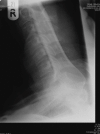The Swimmer's view: does it really show what it is supposed to show? A retrospective study
- PMID: 18197973
- PMCID: PMC2241593
- DOI: 10.1186/1471-2342-8-2
The Swimmer's view: does it really show what it is supposed to show? A retrospective study
Abstract
Background: One of the basic principles in the primary survey of a trauma patient is immobilisation of the cervical spine till cleared of any injury. Lateral cervical spine radiograph is one of the important initial radiographic assessments. More than often additional radiographs like the Swimmer's view are necessary for adequate visualisation of the cervical spine. How good is the Swimmer's view in visualisation of the cervical spine after an inadequate lateral cervical spine radiograph?
Methods: 100 Swimmer's view radiographs randomly selected over a 2 year period in trauma patients were included for the study. All the patients had inadequate lateral cervical spine radiographs. The radiographs were assessed with regards to their adequacy by a single observer. The criteria for adequacy were adequate visualisation of the C7 body, C7/T1 junction and the soft tissue shadow.
Results: Only 55% of the radiographs were adequate. None of the inadequate radiographs provided adequate visualisation of the C7 body and the C7/T1 junction. In 42.2% radiographs the soft tissue shadow was unclear. Poor exposure accounted for 53% of the inadequacies while overlapping bones accounted for the rest.
Conclusion: Clearing the cervical spine prior to removing triple immobilisation is essential in a trauma patient. This needs adequate visualisation from C1 to C7/T1 junction. In our study Swimmer's views did not satisfactorily provide adequate visualisation of the cervical spine in trauma patients. We recommend screening the cervical spine by a CT scan when the cervical spine lateral radiographs and Swimmer's views are inadequate.
Figures
References
-
- Ajani A, Cooper D, Scheinkestel C, Laidlaw J, Tuxen D. Optimal assessment of cervical spine trauma in critically ill patients: a prospective evaluation. Anaesthesia and Intensive Care. 1998;26:487–491. - PubMed
-
- Berne J, Velmahos G, El-Tawil Q, Demetriades D, Asensio J, Murray J, Cornwell E, Belzberg H, Berne T. Value of complete cervical helical computed tomographic scanning in identifying cervical spine injury in the unevaluable blunt trauma patient with multiple injuries: a prospective study. Journal of Trauma. 1999;47:896–903. - PubMed
-
- Macdonald RL, Schwartz ML, Mirich D, Sharkey PW, Nelson WR. Diagnosis of cervical spine injury in motor vehicle crash victims: how many x-rays are enough. J Trauma. 1990;30:392–7. - PubMed
MeSH terms
LinkOut - more resources
Full Text Sources
Medical
Miscellaneous



